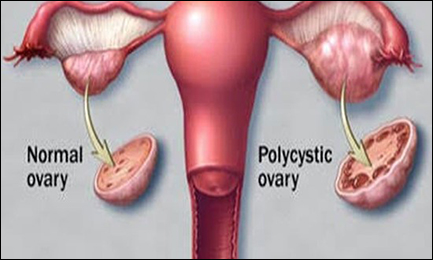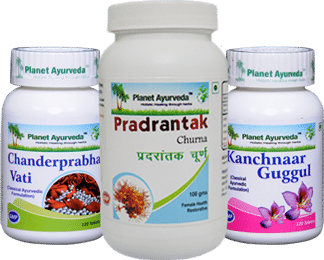Yoga Asanas for PCOD, and Ayurvedic Treatment

What is PCOD ?
PCOD stands for Polycystic Ovarian Disease. As we know, Hormonal disorders are very commonly seen in females of almost all age group, PCOD is one of them. The name itself describes that it is a disease in which many cysts are formed in the ovary.
It is mainly due to hormonal imbalance and our lifestyle, poor diet and lack of physical exercise also play their role, but it can be genetic also. Clinical feature of PCOD includes – Menstrual irregularity. In PCOD, the size of the ovary increases.
Level of Estrogen and Androgen increases in the blood. Androgen is a male hormone and is found in very less quantity in females, but in PCOD its level increases in females which lead to the development of multiple cysts in the ovary. PCOD can lead to infertility, if not treated on time.
Yoga Asanas Recommended for PCOD
Yoga Asanas are nowadays very useful for overall well-being. Many celebrities practice them to keep themselves fit, healthy and young. They can be followed as a supplement for almost all diseases. Women with PCOD can follow these asanas along with their medicines, for better results. These Yoga Asanas keep body healthy and fit and they can be used as an adjuvant to other medicines.
Benefits of Yoga
Yoga serves various benefits –
- Yoga helps in weight loss.
- Yoga improves fertility.
- Yoga helps in reducing stress.
- Yoga helps in maintaining gastrointestinal balance.
Yoga Asanas for PCOD
1. Shavasana (Corpse Pose)
Lie down on the ground without taking any cushion or pillow, keep your legs slightly apart by keeping your knees and feet relaxed. Keep your hands on both sides slightly apart with palms open and facing upwards. Now take a slow and deep breath. After 10 minutes relax, gently get up from the ground.
Benefits – Are as follows –
- Effective for PCOD cases
- Useful in relieving stress, depression
- Useful to keep mind and body healthy
2. Padmasana (Lotus Pose)
Sit on the ground with spine straight. Bend the right knee and keep it over left thigh with the right sole facing upwards and close to the abdomen. In the same way bend the left knee and keep it over right thigh with the left sole facing upwards and close to the abdomen. Keep your head straight while crossing both legs and place both hands over your knees. Maintain this posture for 1 minute while breathing gently and slowly.
Benefits – They are as follows –
- Effective for PCOD cases
- Reduces menstrual discomfort
- Relaxes mind and body
- Controls blood pressure
3. Balasana (Child’s Pose)
Kneel down on the yoga mat by sitting on the heels. Now keep your knees separated and bring your head down in front to touch the floor and lay your torso down between your thighs. Now place your hands on the floor at the side of the torso and relax your shoulders. Maintain this posture for 30 seconds to 1 minute.
Benefits – They are as follows –
- Relaxes the central nervous system
- Helpful in PCOD
- Keep you tension free
- Helpful in menstrual cramps
4. Dhanurasana (Bow Pose)
Lie on your stomach with arms resting on the sides of the body and feet resting hip-width apart and grip your ankles. Fold the knees and bring them near the hips. Lift your chest little up from the ground and pull your legs up to take the shape of an arched bow. Stay in this pose for 30 seconds and take deep breaths.
Benefits – They are as follows –
- Useful in PCOD
- Useful in normalizing the menstrual cycle and relieving menstrual discomfort
- Helpful in kidney disorders
- Keep chest, neck and shoulders muscle healthy
5. Naukasana (Boat Pose)
Lie down on the back by keeping both feet joined together with arms resting beside the body. Now take a deep breath and lift up your head, chest and feet little above the ground. Keep your eyes, fingers and toes in straight direction while breathing deeply. Feel the tension in the abdominal muscles and navel. Keep in this pose for 30 seconds.
Benefits – They are as follows –
- Best Yoga for weight loss.
- Helps to flatten your tummy.
- Helps to enhance the ovary function.
- Helps to maintain healthy functioning of the reproductive organs.
- Useful in PCOD.
Ayurvedic Perspective of PCOD
According to Ayurveda, PCOD mainly occurs due to Vata and pitta doshas occurring due to Kapha blocking pathway. Kapha affects the jatharaagni (digestive fire), resulting in accumulation of impurities and toxins in Rakta dhatu and rasa, leading to cysts formation. Excessive consumption of contraceptive pills, unhealthy lifestyle and improper diet contributes to this disease.
Ayurvedic Treatment for PCOD by Planet Ayurveda
Planet Ayurveda offers best herbal remedy for PCOD, known as Anti-Ovarian Cyst Pack. All these medicines are pure, natural and vegetarian. They are free from side effects and can be used safely. Anti-Ovarian Cyst Pack includes –
1. Chanderprabha Vati
It mainly balances the disturbed kapha dosha, which is seen in PCOD. It is also useful in urinary diseases, cancers, diabetes, obesity and general weakness. Its ingredients are – Chavya (Piper chaba), Vidanga (Embelia ribes), Guduchi (Tinospora cardifolia), Shunthi (Zingiber officinalis), Survarchallavan (Sodium sulphate), Vidalavan (Black salt), Danti (Baliospermum montanum), Dalchini (Cinnamomum zeylanica), Guggul (Commiphora mukul), Sharkara (Sugar), Shilajit (Asphaltum), Amalki (Emblica officinalis), Maricha (Piper nigrum), Pippali (Piper longum), Sarjikashaar (Sodium carbonate), Mustak (Cyprus rotundus), Haridra (Curcuma longa), Yavkshaar (Potassium carbonate), Tejpatta (Cinnamomum tamala), Ela (Elettaria cardamomum), Karpoor (Cinnamomum camphora), Vacha (Acorus calamus) and Saindhavlavan (Rock salt).
Dosage – 2 tablets twice daily after meals with warm water.
2. Kanchnaar Guggul
This herb is very beneficial to balance all the three doshas (Vata, Pitta and Kapha). It prevents the growth of benign and malignant tumors. It shows good result in cysts, fibroids, thyroid problem and unwanted fat in the body. Its ingredients are – Bibhitaki (Terminalia bellerica), Kachnar Bark (Bauhinia variega), Varuna (Crataeva religiosa), Haritaki (Terminalia chebula), Ginger (Zingiber officinale), Black Pepper (Piper nigrum), Pippali (Piper longum) and Amalaki (Emblica officinalis).
Dosage – 2 tablets twice daily after meals with warm water.
3. Pradrantak Churna
It is very useful in female problems like hormonal imbalance, uterine fibroids, ovarian cysts and premenstrual syndrome. It is combination of various herbs like – Ashok (Saraca indica), Udumbur (Ficus glomerata), Arjuna (Terminalia arjuna), and Lodhra (Symplocus racemosa).
Dosage – 1 teaspoonful twice daily after meals with warm water.
Ancient Verse

THE CLASSICAL REFERENCE OF ARJUNA –
Reference – BhavaPrakashaNighantu/VatadiVarga/ Shloka no. 27
Meaning – It means that Arjuna herb having cool potency with astringent taste. It is very beneficial in heart disorders, blood and lymph disorders, general weakness, diabetes, diabetic foot and ulcers seen in diabetes. It is very useful in healing injuries, pacifies pitta and kapha doshas and works as an antidote.




